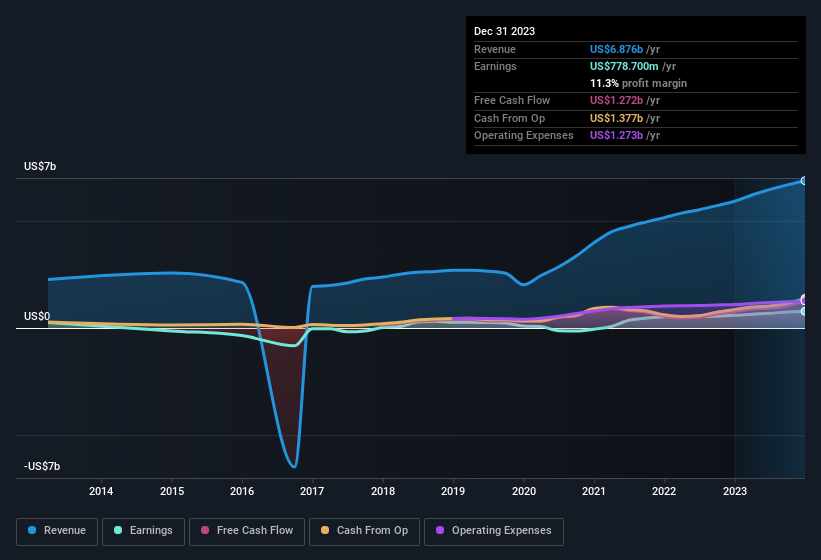We Ran A Stock Scan For Earnings Growth And Ingersoll Rand (NYSE:IR) Passed With Ease
The excitement of investing in a company that can reverse its fortunes is a big draw for some speculators, so even companies that have no revenue, no profit, and a record of falling short, can manage to find investors. But the reality is that when a company loses money each year, for long enough, its investors will usually take their share of those losses. A loss-making company is yet to prove itself with profit, and eventually the inflow of external capital may dry up.
Despite being in the age of tech-stock blue-sky investing, many investors still adopt a more traditional strategy; buying shares in profitable companies like Ingersoll Rand (NYSE:IR). Even if this company is fairly valued by the market, investors would agree that generating consistent profits will continue to provide Ingersoll Rand with the means to add long-term value to shareholders.
View our latest analysis for Ingersoll Rand
How Quickly Is Ingersoll Rand Increasing Earnings Per Share?
Generally, companies experiencing growth in earnings per share (EPS) should see similar trends in share price. So it makes sense that experienced investors pay close attention to company EPS when undertaking investment research. To the delight of shareholders, Ingersoll Rand has achieved impressive annual EPS growth of 46%, compound, over the last three years. That sort of growth rarely ever lasts long, but it is well worth paying attention to when it happens.
Careful consideration of revenue growth and earnings before interest and taxation (EBIT) margins can help inform a view on the sustainability of the recent profit growth. Ingersoll Rand shareholders can take confidence from the fact that EBIT margins are up from 15% to 18%, and revenue is growing. Ticking those two boxes is a good sign of growth, in our book.
You can take a look at the company's revenue and earnings growth trend, in the chart below. For finer detail, click on the image.
While we live in the present moment, there's little doubt that the future matters most in the investment decision process. So why not check this interactive chart depicting future EPS estimates, for Ingersoll Rand?
Are Ingersoll Rand Insiders Aligned With All Shareholders?
Owing to the size of Ingersoll Rand, we wouldn't expect insiders to hold a significant proportion of the company. But thanks to their investment in the company, it's pleasing to see that there are still incentives to align their actions with the shareholders. Holding US$73m worth of stock in the company is no laughing matter and insiders will be committed in delivering the best outcomes for shareholders. This should keep them focused on creating long term value for shareholders.
Does Ingersoll Rand Deserve A Spot On Your Watchlist?
Ingersoll Rand's earnings per share growth have been climbing higher at an appreciable rate. That EPS growth certainly is attention grabbing, and the large insider ownership only serves to further stoke our interest. At times fast EPS growth is a sign the business has reached an inflection point, so there's a potential opportunity to be had here. Based on the sum of its parts, we definitely think its worth watching Ingersoll Rand very closely. You should always think about risks though. Case in point, we've spotted 1 warning sign for Ingersoll Rand you should be aware of.
There's always the possibility of doing well buying stocks that are not growing earnings and do not have insiders buying shares. But for those who consider these important metrics, we encourage you to check out companies that do have those features. You can access a tailored list of companies which have demonstrated growth backed by recent insider purchases.
Please note the insider transactions discussed in this article refer to reportable transactions in the relevant jurisdiction.
Have feedback on this article? Concerned about the content? Get in touch with us directly. Alternatively, email editorial-team (at) simplywallst.com.
This article by Simply Wall St is general in nature. We provide commentary based on historical data and analyst forecasts only using an unbiased methodology and our articles are not intended to be financial advice. It does not constitute a recommendation to buy or sell any stock, and does not take account of your objectives, or your financial situation. We aim to bring you long-term focused analysis driven by fundamental data. Note that our analysis may not factor in the latest price-sensitive company announcements or qualitative material. Simply Wall St has no position in any stocks mentioned.

